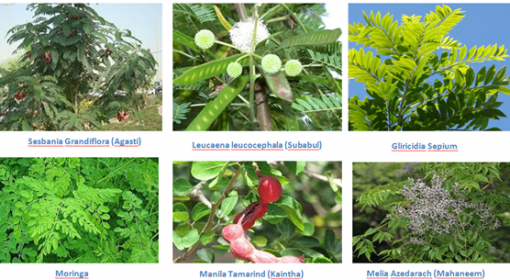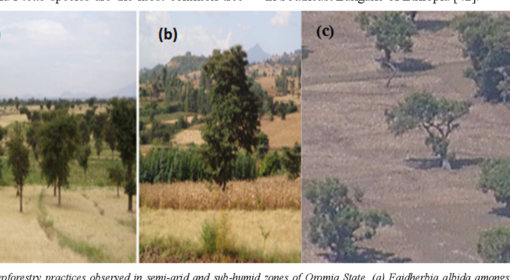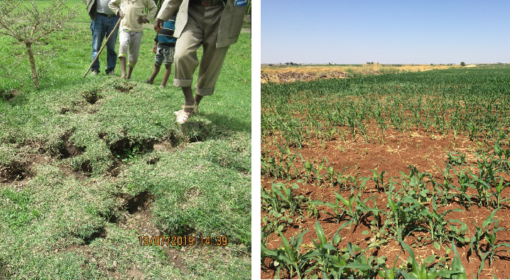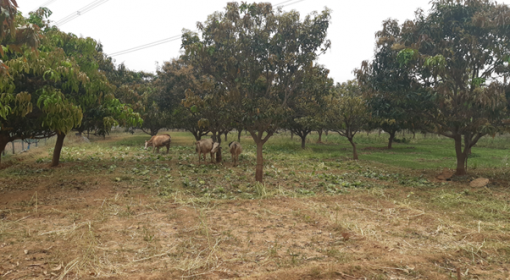By Yuka Nabae
Livestock production continues to result in large-scale deforestation in many areas. In fact, the conversion of forest to cropland and grassland for livestock is amongst the major causes of deforestation with livestock grazing responsible for almost 40% of the agricultural induced deforestation (FAO, 2021).
Unsustainable grazing is often a root cause of other environmental problems, including loss of biodiversity, both above ground as well as in the soil. Biodiversity includes the variation of species in plants and the abundance and diversity of the soil microbial community (Zhang et al., 2021). Overgrazing reduces species diversity in aboveground community because it can converts grassland to bare land (Pulungan et al., 2019). Also, grazing effects on soil microbial diversity are indirectly related to aboveground community plant composition and diversity as overgrazing can lead to changes in plant diversity and reduce the amount of organic matter input into the soil through crop residues and litter. The reduced amount of organic matter in the soil consequently affects the soil microbial biodiversity.
A sustainable, moderate, grazing intensity, can improve plant diversity. The reason for this is because grazing ensures light availability for the subordinate species by removing above-ground biomass of dominant species. The relationship between grazing intensity and biodiversity is shown in the MSL (Milchunas–Sala–Lauenroth) model, which shows a linear negative effect of grazing on biodiversity (Figure 2).
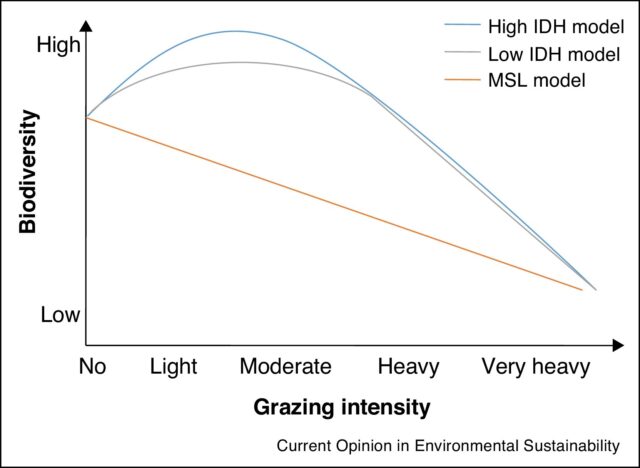
Silvopasture grazing systems can minimise the negative effect of overgrazing induced biodiversity loss. Silvopasture is a type of agroforestry system consisting of the intentional combination of trees, forage plants, and livestock together as an integrated, intensively-managed production system. In such a system, woody plants provide animal feed, timber, and fruit as well as help to increase biodiversity and regulate soil and water cycles (FAO, 2022).
Silvopasture with scattered trees for shade can provide greater biodiversity and ecological benefits than monocultures or degraded fallow lands by creating a diverse habitat mosaic, offering refuge and resources for various species. For example, birds can nest among the branches, the increased plant life attracts many insects, and small mammals seek shelter in the understory. This abundance of biodiversity provides essential ecological services like pest control and pollination, benefiting neighbouring agricultural areas. A recent study showed that transitioning from monocultural pastures to silvopasture had profound implications for insect populations engaged in critical ecosystem functions (Paiva et al. 2020). It is also known that silvopasture systems improve soil conditions that create greater microhabitat diversity in below ground community (Paiva et al. 2020).
Zooming in on Ethiopia
The negative effects of overgrazing on ecosystems are also an emerging issue in Ethiopia. In the highlands of Ethiopia that is mainly under a traditional free-grazing system, land degradation is observed (Taddese, 2001). The absence of a formal grazing policy and mismanagement of shared grazing land are among the causes of overgrazing and land degradation. Grazing land in this system is perceived as a shared resource over which nobody has direct responsibility and whose utilization is open to all members of a community, and thus is typically under enormous threat (Alemayehu, 2006).
In Ethiopia, National Biodiversity Strategies and Action Plans (NBSAPs) have been implemented and guided the national efforts in the sustainable land management and prevent biodiversity loss. Ethiopian government target to reduce unsustainable grazing by 2020 (Government of the Federal Democratic Republic of Ethiopia, 2005). However, Government of the Federal Democratic Republic of Ethiopia (2020) evaluated that the progress toward target in NBSAPs was not so significant due to inadequate data, inadequate financial resources and lack of stakeholders collaboration.
As the population grows, livestock ownership continues to increase, resulting in a shortage of grazing pasture. Consequently, the depletion of pastures causes livestock-dependent households to rely heavily on illegal grazing practices and foraging of protected land – when available. Many farmers let their livestock graze in protected national parks, which are intended to protect rare endemic flora and fauna (Llyin, 2011). The Ethiopian biodiversity is thus threatened under the tendency of overgrazing.
Potential of silvopasture in Ethiopia to secure biodiversity
Given the need of preserving its natural areas to rapid population growth, increasing livestock populations, and the impacts of climate change, silvopasture has gain attention in Ethiopia. For instance, the integration of indigenous tree species into silvopasture systems to provide supplemental fodder is being observed in several local communities (Balehegn and Eniang, 2009). Indigenous fodder trees play a crucial role in animal feed and agro-biodiversity. They are particularly valued for their high crude protein content, making them recommended supplements, inclusions, or even replacements for commercial concentrates. Besides their nutritional benefits, these versatile trees offer various services like food, fibre, shade, soil improvement, conservation, timber, firewood, and live fences (Balehegn, 2017). By incorporating indigenous fodder trees into silvopasture systems, one not only addresses livestock feed challenges but also contributes to environmental rehabilitation, stability, and improved livelihoods (Murgueitio et al., 2011).
For example, the impact of incorporating Ficus thonningii (locally known as Shibaka) into silvopastures goes beyond improving livelihoods; it also contributes to bolstering biodiversity and the ecological resilience of fragile landscapes. By reintroducing Shibaka into these areas, once locally extinct wildlife, including small mammals, resident, and migratory birds, have been attracted back. For example, the return of the endangered White-Billed Starling, which has found a sanctuary in the thriving silvopasture, resulted in a considerable increase in its population in the area where Shibaka has been planted (AFSA, 2018). This restoration of wildlife and bird species highlights the positive impact of these silvopasture on the overall biodiversity and ecological health of the region. Shibaka also reaches maturity within a relatively short span of 1.5 to 2 years, providing abundant and nutritious green fodder that can sustain livestock throughout the year.
Implementing silvopasture systems also comes with challenges. Ethiopia is prone to drought and that even challenge some of the indigenous trees in their survival. In this case, it is important to select trees that have an excellent ability to retain their green foliage even in severe drought. Ficus thonningii is one tree that has this characteristic.

In order to improve the management of the grazing land, it is vital to raise the recognition of the drought tolerance of the silvopasture system with Shibaka. Peer-to-peer learning is one of the effective ways to encourage farmers to take up new practices in the region and allow them to see the benefits of the practice with their own eyes in a context similar to their own.
References
- Alliance for Food Sovereignty in Africa (AFSA). (2018). Drought tolerant Ficus thonningii silvopastures sustain livestock and crops in Northern Ethiopia https://afsafrica.org/wp-content/uploads/2019/07/ficus-thonningi-eng-online.pdf
- Balehegn, M. (2017). Silvopasture Using Indigenous Fodder Trees and Shrubs: The Underexploited Synergy Between Climate Change Adaptation and Mitigation in the Livestock Sector. In: Leal Filho, W., Belay, S., Kalangu, J., Menas, W., Munishi, P., Musiyiwa, K. (eds) Climate Change Adaptation in Africa. Climate Change Management. Springer, Cham. https://doi-org.ezproxy.library.wur.nl/10.1007/978-3-319-49520-0_30
- Balehegn, M. (2018) . Drought tolerant Ficus thonningii silvopastures sustain livestock and crops in Northern Ethiopia, AFSA. https://afsafrica.org/wp-content/uploads/2019/07/ficusthonningi-eng-online.pdf
- Balehegn, M., & Eniang, E. A. (2009). Assessing indigenous knowledge for evaluation, propagation and conservation of indigenous multipurpose fodder trees towards enhancing climate change: Adaptation in Northern Ethiopia. Traditional forest-related knowledge and sustainable forest management in Africa: IUFRO World Serives volume 23 (pp. 39– 46). International Union of Forest Research Organizations
- (2021) COP26: Agricultural expansion drives almost 90 percent of global deforestation. FAONewsroom.https://www.fao.org/newsroom/detail/cop26-agricultural-expansion-drives-almost-90-percent-of-global-deforestation/en
- 2022. Grazing with trees – A silvopastoral approach to managing and restoring trees. FAO Forestry Paper, No. 187. Rome. https://doi.org/10.4060/cc2280en
- Government of the Federal Democratic Republic of Ethiopia. (2015). ETHIOPIA’S NATIONAL BIODIVERSITY STRATEGY AND ACTION PLAN 2015-2020. Addis Ababa, Ethiopia: Ethiopian Biodiversity Institute.
- Government of the Federal Democratic Republic of Ethiopia. (2020). SIXTH NATIONAL REPORT ON THE IMPLEMENTATION OF Et_NBSAP 2015-2020. Addis Ababa, Ethiopia: Ethiopian Biodiversity Institute.
- Ilyin, S. (2011). The Looming Threat of Overgrazing: Effects and Recommendations. Congressional Hunger Center. https://www.hungercenter.org/publications/the-looming-threat-of-overgrazing-effects-and-recommendations/
- Murgueitio, E., Calle, Z., Uribe, F., Calle, A. & Solorio, B. (2011). Native trees and shrubs for the productive rehabilitation of tropical cattle ranching lands. Forest Ecology and Management, 261, 1654–1663
- Paiva, I.G., Auad, A.M., Veríssimo, B.A. et al. Differences in the insect fauna associated to a monocultural pasture and a silvopasture in Southeastern Brazil. Sci Rep 10, 12112 (2020). https://doi-org.ezproxy.library.wur.nl/10.1038/s41598-020-68973-5
- Pulungan, M.A., Suzuki, S., Gavina, M.K.A. et al. Grazing enhances species diversity in grassland communities. Sci Rep 9, 11201 (2019). https://doi-org.ezproxy.library.wur.nl/10.1038/s41598-019-47635-1
- Ruiyang Zhang, Jinsong Wang, Shuli Niu (2021).Toward a sustainable grazing management based on biodiversity and ecosystem multifunctionality in drylands,Current Opinion in Environmental Sustainability,Volume 48, Pages 36-43,ISSN 1877-3435 https://doi.org/10.1016/j.cosust.2020.09.005.
